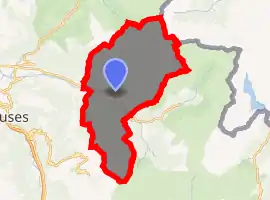Samoëns
Samoëns (French pronunciation: [samwɛ̃]) is a commune in the Haute-Savoie department in the Auvergne-Rhône-Alpes region in south-eastern France. It is the principal commune for the canton which bears its name. The town of Samoëns is located in the Vallée du Giffre (Giffre Valley) in the French Alps.
Samoëns | |
|---|---|
 A general view of Samoëns | |
.svg.png.webp) Coat of arms | |
Location of Samoëns 
| |
 Samoëns  Samoëns | |
| Coordinates: 46°05′05″N 6°43′41″E | |
| Country | France |
| Region | Auvergne-Rhône-Alpes |
| Department | Haute-Savoie |
| Arrondissement | Bonneville |
| Canton | Cluses |
| Government | |
| • Mayor (2014–2020) | Jean-Jacques Grandcollot |
| Area 1 | 97.29 km2 (37.56 sq mi) |
| Population (2017-01-01)[1] | 2,458 |
| • Density | 25/km2 (65/sq mi) |
| Time zone | UTC+01:00 (CET) |
| • Summer (DST) | UTC+02:00 (CEST) |
| INSEE/Postal code | 74258 /74340 |
| Elevation | 671–2,665 m (2,201–8,743 ft) (avg. 710 m or 2,330 ft) |
| 1 French Land Register data, which excludes lakes, ponds, glaciers > 1 km2 (0.386 sq mi or 247 acres) and river estuaries. | |
Stonemasons
Stone has long been a traditional feature of the Upper Giffre Valley which is dotted with limestone quarries (hardness coefficient, 13). To supplement their income from farming, the men in the region used to work stone.
In 1659, there were so many frahans (the local name for stonecutters and masons)[2] in Samoëns and their expertise was so well known that they set up a very famous brotherhood. It engaged in charity work, taking care of the sick and training young apprentices in its own school of draughtsmen, which had an extensive library.
The members of the brotherhood of masons and stonecutters in Samoëns were contacted for leading construction projects. They worked with Vauban on his fortifications, were commissioned by Napoleon Bonaparte to build canals in Saint-Quentin, and worked in Givors and even further afield, in Poland, Louisiana and Australia.
To ensure that they were not understood by outsiders when talking to each other, they used their own dialect, called mourmé.[2]
Evidence of their work can be seen all over the village, in its architecture. Even now, there are a number of stonecutters upholding the tradition in Samoëns and the brotherhood has become a cultural association, the Société des Maçons.
Tourist destination
The town carries the designation of a "ville fleurie" distinguishing it as one of the most beautiful towns in France.[3]
Approximately a 70 km drive from Geneva Airport,[4] Samoens is a popular summer destination as well as the site of a ski resort that departs from a new lift (Grand massif Express) at the edge of town linking up to Samoëns 1600 also known as the Plateau des Saix, this resort is part of the larger five-town Grand Massif which includes Flaine and Morillon.[5]
Samoëns has been awarded the 'Famille Plus Montagne' label, making it a great destination for a family ski holiday.[6]
Samoëns is the only winter sports resort to be classified by the Caisse Nationale des Monuments Historiques.
As well as skiing, Samoens offers a range of non-skiing activities including dog-sledding, indoor climbing, caving and diving under ice.[7]
Jaysinia and the Cognac-Jaÿ Foundation
Jaÿsinia (3.7 hectares) is a botanical garden specializing in alpine flowers, established in 1906 by Marie-Louise Cognacq-Jaÿ, a native of Samoëns and founder of La Samaritaine department store in Paris. Since 1936 it has been directed by the Scientific Division of Botany from the National Museum of Natural History. It is open all year and is free of charge.
Chapels
There are nine chapels in and around Samoëns, in addition to many shrines and other cultural buildings. Most were built in the 17th century, except for the chapel in Le Bérouze – dating from the 15th century – and the one in Les Allamands, dating from the 19th century.
Two of these buildings were moved from the sites where they were originally constructed. The chapel in Le Bérouze was originally built at the mountain pass known as "Col de Couz", but it was badly damaged during an invasion by Swiss troops in 1476. Four years later, it was decided to rebuild it on the main square. In Mathonex, the chapel now overlooks the village, but the original building was much closer to the village centre; its relocation became a necessity after a landslide.
See also
- Reseau Jean Bernard
- Grand Massif
- Morillon, neighbouring commune
- Communes of the Haute-Savoie department
References
- "Populations légales 2017". INSEE. Retrieved 6 January 2020.
- J. Desormaux, "Mélanges savoisiens, VIII. L'argot des ramoneurs", (1912) 26 Revue de philologie française et de littérature p 77 (ISSN 1245-5733), Gallica, Bibliothèque nationale de France, département Littérature et art, 8-X-4072, 2011 accessed 7 January 2013. "Le mourmé, parlé à Samoëns, comme le mènedigne ou mannedigne, en usage à Morzine et à Montriond, est l'argot propre aus frahans, tailleurs de pierre et maçons de ces localités du Chablais." (mourmé, spoken at Samoëns, as with mènedigne or mannedigne, in use at Morzine and at Montriond, is the argot of the frahans, stonecutters and masons of these places in Chablais district.)
- "Les villes et villages fleuris (Towns and villages in bloom)" (in French). Conseil National des Villes et Villages Fleuris (Paris). Archived from the original on 18 December 2012. Retrieved 7 January 2013.
- "Driving Directions to Ferme du Ciel, Luxury Chalet in Samoëns".
- http://www.peakretreats.co.uk/winter/ski-resorts/grand-massif/samoens
- http://www.skiingsamoens.co.uk/
- "GrandMassif.co.uk".
For Premier Accommodation in Samoens please visit www.alpsaccommodation.com